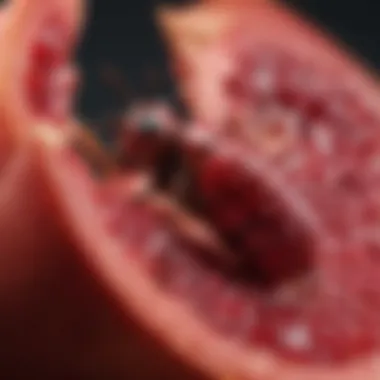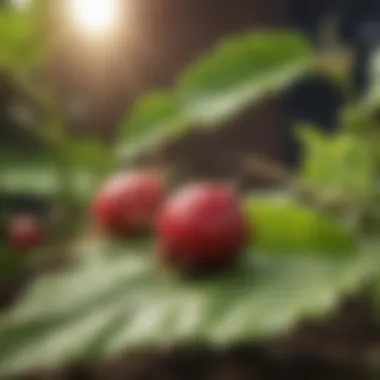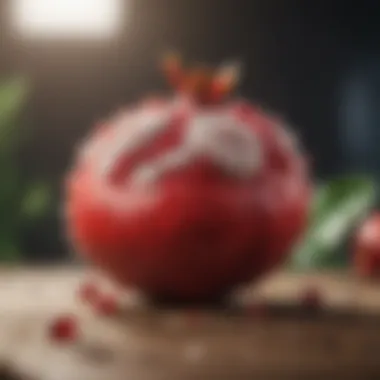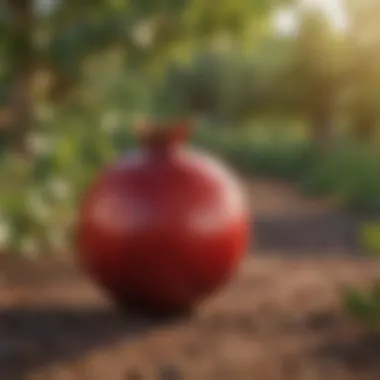Identifying and Managing Pomegranate Pests Effectively


Intro
The cultivation of pomegranates has gained significant traction in diverse agricultural regions due to their rich nutritional value and potential market appeal. However, these fruitful wonders are not without their challenges. Pomegranate pests, in particular, pose a substantial threat to the health and yield of these plants. Understanding the intricacies of pest identification, their ecological impacts, and effective management strategies is vital for any grower aiming to cultivate thriving pomegranate orchards.
This guide aims to unravel the complexities surrounding primary pests such as the pomegranate fruit borer, aphids, and mealybugs. Each pest not only brings unique challenges but also demands tailored solutions that align with best practices in integrated pest management (IPM). Furthermore, we will explore the ecological implications of pest control, stressing the necessity for a balanced approach that safeguards both plant vitality and environmental integrity.
Let’s dig deeper into the world of pomegranate pests.
Prelude to Pomegranate Pests
Pomegranate cultivation has gained considerable traction in the agricultural sector due to the fruit's nutritional benefits and market demand. Therefore, understanding the array of pests that threaten pomegranate crops is imperative for farmers and agriculturalists alike. Recognizing these pests, their impact on plant health, and effective management strategies is crucial to sustaining healthy yields. This section aims to dissect the challenges posed by various pests, shedding light on why vigilance in pest management is a necessity in ensuring the longevity and productivity of pomegranate trees.
Significance of the Pomegranate Crop
The pomegranate, known scientifically as Punica granatum, holds a royal place in many cultures. It's cherished not just for its juicy arils but also for its antioxidants and potential health-promoting properties. The increasing popularity of pomegranates in culinary dishes and health-conscious diets has triggered a rise in pomegranate farming.
However, the significance extends beyond just economic factors. Pomegranates are often considered a symbol of fertility and prosperity in different cultures, making their cultivation a deeply rooted practice for many communities. In terms of economic value, they play an essential role in agrarian economies, offering farmers a lucrative outlet in both local and international markets. As such, safeguarding these crops from pest infestations is vital to maintaining their socioeconomic importance.
Overview of Pest Challenges
The road to fruitful pomegranate harvests is often marred by a multitude of pest-related challenges. It is not uncommon for farmers to face a raiding party of pests ready to wreak havoc on their crops. This section hints at the critical role pests play in reducing yield quality and quantity.
Some of the major pest-related challenges include:
- Pomegranate Fruit Borer: This notorious pest can devastate the fruit, creating holes that become entry points for diseases.
- Aphids and Mealybugs: These sap-sucking insects can stress plants significantly, causing wilting and poor fruit development.
- Whiteflies: Not only do they sap nutrients, but they also produce honeydew, leading to sooty mold, which can choke the plant's ability to photosynthesize.
Adopting an informed approach to pest management can radically shift the dynamics at play for pomegranate farmers. Being proactive rather than reactive can mean the difference between a bountiful harvest and a meager yield. The next sections will delve deeper into the identification of these pests, their life cycles, and the best methods for managing them effectively.
Common Pomegranate Pests
The significance of understanding common pomegranate pests in this article cannot be overstated. Pomegranate trees, celebrated for their luscious fruits and vibrant blossoms, face a daunting array of pests that can undermine their health and yield. Thus, identifying the pests that commonly invade these plants is crucial for effectively managing the issues that arise. Knowing these pests not only helps gardeners and farmers safeguard their investments but also enhances the overall sustainability of pomegranate cultivation.
Pomegranate Fruit Borer
Life Cycle of the Pomegranate Fruit Borer
The life cycle of the pomegranate fruit borer is vital to understand for anyone involved in pomegranate cultivation. This pest undergoes complete metamorphosis, transitioning from egg to larva and then to an adult, which typically spans several weeks. Key characteristics to note include the female's propensity to lay eggs directly on fruit surfaces, an action crucial in ensuring the larvae have immediate access to their primary food source. This trait makes it particularly worrisome; without careful monitoring, damage can escalate rapidly. The unique feature of its rapid population growth during the warm months can quickly turn a minor problem into a major issue, raising serious concerns for overall fruit production.
Signs of Infestation
Identifying signs of fruit borer infestation is imperative for managing their impact early on. Early indicators often include small holes in fruits and a flow of gum or sap from the damaged areas. These symptoms signal that larvae are likely feeding within the fruit, highlighting their voracious feeding habits. The urgency of identifying these signs cannot be stressed enough, as catching them at this stage can mean the difference between a healthy harvest and severe crop loss. One unique aspect of infestation is that physical damage can severely weaken fruit quality, further complicating management strategies down the line.
Damage Assessment
Assessing the damage inflicted by the pomegranate fruit borer is another critical step in pest management. This evaluation involves checking for both external and internal damage caused by the insects. Fruit that appears blemished or rotten can signal larval activity, affecting both marketability and consumption. Additionally, the overall vitality of the tree can suffer due to the energy expended in producing damaged fruits. This underscores the necessity of conducting thorough assessments to determine effective control measures, as a precise understanding of damage can guide timely interventions.
Aphids
Identification of Aphid Species
When it comes to identifying aphids, distinguishing between species can be crucial, as their various forms may have different impacts on pomegranate trees. Common species include the green peach aphid and the black bean aphid. Their small size and varied color can make them challenging to spot, but their clustered presence on new growth is a telltale sign. Knowing which species are prevalent can help determine the best control strategy to adopt. The identification not only aids in immediate action but also informs long-term management practices, as different species may require varied approaches.


Feeding Habits and Effects
Aphids feed by puncturing the plant tissue and extracting sap, which can lead to nutritional stress on the pomegranate tree. Their feeding habits often result in stunted growth, yellowing leaves, and even fruit drop. This impact goes beyond aesthetics, as the overall health of the tree becomes compromised. Understanding these consequences is beneficial, as it helps in recognizing when intervention is necessary. The unique aspect of their reproductive strategy—rapid reproduction under favorable conditions—means that a small aphid problem can escalate quickly, causing cascading effects on plant health.
Control Measures
Implementing effective control measures against aphids is essential for securing pomegranate yield. Options may range from insecticidal soaps designed to disrupt aphid feeding, to natural remedies like introducing ladybugs. The key takeaway here is that proactive measures can make a world of difference. The unique feature of employing integrated pest management strategies allows for a reduction in chemical usage while still managing pest levels. The dual aim of preserving ecological balance while maintaining crop yield is an excellent approach.
Mealybugs
Recognizing Mealybug Infestation
Recognizing a mealybug infestation involves looking for white, cotton-like masses on leaves and stems. These pests tend to cluster, making their soft bodies easy to overlook for those not vigilant. Early detection is key; once they establish themselves, eradicating them becomes significantly more challenging. The conspicuous appearance of mealybugs is one unique identifier that can help ward off extensive damage through timely intervention.
Implications on Plant Health
Mealybugs can cause severe implications for plant health, including the secretion of honeydew, which can lead to sooty mold and hinder photosynthesis. A reduction in sunlight exposure aggravates stress on the tree, further compounding the issue. This nutrient stress manifests quickly, and lingers effects can lead to long-term reductions in fruit quality and quantity. By understanding these implications, growers can appreciate the urgent need for effective management strategies.
Treatment Options
Treatment options for mealybug infestations vary widely, ranging from chemical insecticides to biological controls, such as parasitic wasps. Each option comes with its own advantages and disadvantages; for instance, while chemical treatments may yield immediate results, they can harm beneficial insect populations and disrupt the ecosystem balance. The unique aspect of biological control lies in its sustainability; introducing beneficial insects can provide ongoing management of pests.
Whiteflies
Behavior and Lifecycle
Understanding the behavior of whiteflies adds an essential layer to pest management. These pests reproduce quickly, and their lifecycle can unfold in mere weeks, allowing their populations to explode under favorable conditions. Frequent monitoring can help manage their infestations before they wreak havoc on pomegranate crops. Knowing when they are most active is imperative for targeted interventions, as it allows for timely preventive measures.
Health Risks to Pomegranate
Health risks posed by whiteflies include the transmission of viral diseases that can devastate pomegranate trees. Infested plants may exhibit yellowing leaves and stunted growth, ultimately compromising fruit production. This aspect is a core concern for growers, emphasizing the need for vigilant pest management.
Best Practices for Management
Best practices for managing whiteflies integrate regular monitoring, and some growers have had success using reflective mulches to deter these pests. Employing natural remedies, such as introducing predatory insects or using insecticidal soaps, can be both effective and environmentally friendly. Each practice has distinct benefits and associated risks, underlining the importance of tailoring the approach to the specific conditions of the pomegranate orchard.
Efficient pest management starts with understanding the unique characteristics of each pest, enabling targeted interventions that enhance pomegranate health and fruit quality.
Biological Impacts of Pests on Pomegranate
The biological effects of pests on pomegranate crops can be likened to a slow storm brewing on the horizon. By the time it hits, the consequences can be significant and far-reaching. Understanding these impacts is not just an academic exercise; it’s crucial for anyone involved in the cultivation or management of pomegranates. Here, we delve into the three primary facets of biological impacts due to pest infestations: physical damage to the plants, nutritional stress they impose, and the eventual deterioration in fruit quality.
Physical Damage
Pests don’t just set up camp on a pomegranate tree; they go to town on it. The physical scars left by pests can take various forms. For instance, the pomegranate fruit borer makes small holes where it has bored into the fruit and stems, leaving the plants vulnerable to rot and further infestation. Likewise, aphids suck the sap out of tender growths, leading to distorted leaves and stunted growth.
Effects of Physical Damage:
- Leaf Drop: Affected leaves may drop prematurely, reducing the tree's photosynthetic capacity.
- Fruit Deformities: Unsightly blemishes and uneven growth render the fruit unsalable.
- Increased Disease Susceptibility: Open wounds create avenues for pathogens to enter, making the plant more susceptible to diseases.
These physical damages can cumulatively lead to decreased yield and overall vitality of the plants, pushing growers to seek out robust pest management solutions.
Nutritional Stress


The pests’ appetites can wreak havoc on the nutritional profile of pomegranate trees. As they dine on the leaves and sap, they extract essential nutrients that plants need to thrive. This nutrient removal can induce a state of stress in trees, hindering their growth and overall health.
Consequences of Nutritional Stress:
- Compromised Photosynthesis: Leaves play a pivotal role in producing energy; with pests sucking away nutrients, the tree’s ability to photosynthesize may decrease, stunting growth.
- Poor Fruit Development: As nutritional levels dwindle, the trees may produce smaller, less sweet fruits that lack the signature pomegranate taste.
- Long-term Soil Impact: Constant stress from pests may force trees to rely on depletion of soil nutrients, leading to a long-term health crisis for the land.
Understanding these impacts is vital for farmers aiming for sustainable practices, as the negative spiral of nutritional deficits can be hard to reverse.
Impacts on Fruit Quality
Finally, let's chat about what everyone really cares about: the quality of the fruit. Pests not only interfere with the growth process but also have a direct impact on the marketability of the pomegranate itself. Fruits can become a shadow of their former selves due to the persistent nibbling and sucking of these nuisances.
Key Quality Effects:
- Flavor Reduction: Fruits that develop under stress from pests often lack the robust flavor and sweetness that pomegranate lovers expect.
- Appearance: Pests can cause surface blemishes, making fruits visually unappealing. No shopkeeper wants a basket of bruised offerings on display.
- Shelf Life: Infested fruits are often more susceptible to decay, reducing their market value and consumer satisfaction.
"Healthy fruit quality means better acceptance by consumers and higher prices in the market. Therefore, managing pests effectively is essential for both growers and their livelihoods."
In summary, the biological impacts that pests have on pomegranates extend well beyond just the immediate visible damage. They cascade through a series of repercussions that can affect plant vitality, nutrient availability, and ultimately fruit quality. As growers navigate these challenges, recognizing the multifaceted nature of pest impact becomes indispensable.
Integrated Pest Management Strategies
In the realm of pomegranate cultivation, the integrated pest management (IPM) approach stands out as a practical and holistic solution. It encompasses multiple strategies aimed at damaging pests while safeguarding the environment and the overall ecosystem. These strategies work synergistically to enhance the health of the pomegranate plants, ensuring not just yield but also quality fruits. The essence of IPM lies in its flexibility and adaptability, acknowledging that each pest scenario is unique, which in turn allows growers to tailor their methods accordingly.
Cultural Practices
Crop Rotation
Crop rotation involves alternating the types of crops grown on a particular piece of land over seasons. For pomegranate growers, this practice serves as a vital tool in pest management. By rotating out pomegranates for other plants, growers disrupt the lifecycle of pests like aphids and fruit borers, which thrive on consistent crop availability. This key characteristic of crop rotation promotes soil health and can break pest cycles, reducing the reliance on chemical interventions.
Its unique feature stems from the way it encourages biodiversity, allowing beneficial organisms to flourish. On the flip side, it might require a more in-depth understanding of crop compatibilities, which can be challenging for less experienced farmers. Nonetheless, its benefits often outweigh the disadvantages, making it a popular method among sustainable agriculture enthusiasts.
Sanitation Techniques
Sanitation techniques encompass various practices aimed at minimizing pest habitats and life cycles, significantly contributing to pest control. Regularly cleaning the fields, removing debris, and disposing of infected plants can prevent the establishment of pest populations. This proactive approach is foundational in managing pomegranate pests, allowing growers to nip problems in the bud.
The crux of sanitation lies in its simplicity. Routine activities can lead to significant reductions in pest presence. However, one must note that maintaining consistent sanitation can be labor-intensive, especially for larger operations. Still, this method is often viewed as essential due to its low cost and wide applicability.
Biological Control
Beneficial Insects
Beneficial insects, such as ladybugs and lacewings, play a pivotal role in biological pest control. These insects are nature's little warriors, actively preying on harmful pests like aphids and mealybugs. Their presence in pomegranate orchards fosters a natural balance, allowing growers to rely less on synthetic chemicals.
One of the standout aspects is that beneficial insects reproduce quickly, leading to sustained pest control. They require minimal intervention once established in the environment. However, these insects can be affected by pesticide applications, which is a consideration that growers must keep in mind to avoid upsetting the balance they help maintain. Hence, encouraging their presence is generally seen as a strategic choice in the long-term care of pomegranate crops.
Natural Predators
Natural predators are part of the ecosystem's intricate balance and are critical in managing pest populations. Birds, spiders, and predatory beetles often find their way into pomegranate groves, providing an additional layer of pest control. By nurturing habitats that attract these avian and arboreal allies, growers can fortify their pest management strategies.
The key characteristic of using natural predators is that they are generally self-sustaining. Once established, they can continuously keep pest outlets in check without the need for continuous human intervention. However, a potential downside is their reliance on the availability of food sources and shelter. If conditions fluctuate, this balance may sway, necessitating augmentative efforts by the grower. But despite this, their role in an IPM strategy cannot be overlooked, as they symbolize a nature-based solution.
Chemical Control


Selecting Appropriate Pesticides
Chemical control involves the application of pesticides to manage pest populations effectively. However, selecting appropriate pesticides is key in minimizing adverse impacts while maximizing effectiveness. A grower’s choice should hinge on the target pest's biology, life cycle, and resistance patterns. Hence, ongoing education is crucial in this regard.
The major characteristic of appropriate pesticide selection is that it encourages integrated management by focusing on specific pests rather than broad-spectrum options. This practice aids in reducing the chance of pest resistance developing. On the downside, there's the ever-present risk of environmental toxicity or impacting non-target species if not used judiciously.
Timing of Application
The timing of pesticide application is equally as important as choosing the right product. Spraying at the peak times of pest activity can dramatically enhance efficacy. Understanding when pests are most vulnerable or when they are beginning to establish is essential for effective pest management.
A crucial attribute of timing is that it can maximize results while reducing the amount of pesticide used. Health and environmental implications can also be minimized through careful scheduling. Nevertheless, predicting pest emergence can be challenging due to environmental variables that can disrupt expected timings. Nevertheless, the practice remains a key element of successful pest management strategies for pomegranate growers.
Ecological Considerations in Pest Management
When delving into the world of pomegranate cultivation, it's essential to consider the ecological backdrop of pest management. The relationship between pests and their environment is complex; thus, understanding this interplay is key. Effective pest control not only safeguards the pomegranate crop but also sustains the wider ecosystem in which it thrives. By factoring in ecological considerations, farmers can adopt strategies that maintain harmony between the agricultural landscape and its natural inhabitants.
Pest management often revolves around balancing the needs of crops with the health of local biodiversity. This balance isn’t simply about reducing pest numbers; it involves fostering a habitat where beneficial organisms can flourish. The presence of diverse plant and animal species often leads to natural pest control mechanisms, reducing the necessity for chemical interventions.
Key points:
- Maintaining Biodiversity: A rich ecosystem filled with various species promotes resilience against pests. More species mean more natural predators for harmful insects.
- Soil Health: Healthy soil contributes to plant vigor and vigor reduces vulnerability to pests. Practices such as crop rotation and cover cropping can enhance soil biology, benefitting the entire cultivation system.
- Water Management: Managing water resources appropriately not only supports the pomegranate trees but also affects pest populations. Overwatering can lead to damp conditions that favor pest outbreaks.
"Biodiversity is the key to successful pest management; it creates a natural buffer against pest outbreaks and enhances long-term sustainability."
Pest Control and Biodiversity
Biodiversity often acts as a silent guardian in the world of agriculture. When fields are rich in various plant species, pests have a harder time establishing themselves. Natural enemies, those beneficial insects like ladybugs or predatory wasps, thrive in diverse environments. This results in biological control methods that are not just effective but also environmentally sound.
Why is biodiversity significant?
- Natural Predation: A mixed ecosystem allows for increased predation of pests, naturally mitigating their populations.
- Plant Resistance: Diversity among plant species may enhance resilience against pest infestations, as some plants can repel pests or attract beneficial insects.
- Soil Microbiome: Diverse root systems contribute to a robust soil microbiome, aiding in plant health and reducing stress from pests.
Promoting biodiversity is a win-win situation. It not only provides a buffer against pests but also nurtures soil and plant health, potentially increasing pomegranate yield and quality.
Sustainable Pest Management Practices
A sustainable approach to pest management takes ecological considerations to heart. These practices are designed to minimize environmental impact while effectively managing pest populations. It’s not just about applying pesticides; it’s about creating a whole system that supports plant health and pest resistance.
Sustainable pest management incorporates several practices:
- Integrated Pest Management (IPM): A holistic approach focusing on monitoring pest populations and using a combination of biological, cultural, and chemical controls. This reduces reliance on any single method.
- Crop Rotation: Frequent changing of crops can disrupt pest life cycles, preventing them from becoming established and causing damage.
- Plant Selection: Choosing pest-resistant pomegranate varieties can greatly reduce the onset of pest issues.
- Natural Pesticides: Utilizing botanicals and other naturally derived solutions can manage pests while being less harmful to beneficial organisms.
In the end, sustainable management practices support the longer goal of preserving ecological balance while ensuring pomegranate trees can thrive.
To wrap things up, ecological considerations in pest management are essential for anyone involved in pomegranate cultivation. A thorough understanding of how pests interact with their environment, coupled with a commitment to promote biodiversity and apply sustainable practices, can lead to healthier crops and a healthier planet.
Closure and Future Directions
The study of pomegranate pests is not just an academic pursuit but a crucial aspect of sustainable agriculture. Ensuring the health of pomegranate trees maximizes their yield and protects the ecosystem that supports them. As we wrap up our exploration of the identification, impact, and management of these pests, it's essential to recognize the key elements that drive the future of pest management.
First off, acknowledging the research gaps in this area is paramount. There’s a pressing need for more in-depth studies into the life cycles and behaviors of emerging pests that may threaten pomegranate crops in the coming years. Without understanding these pests thoroughly, farmers might find themselves grappling with unexpected infestations, leading to potential losses.
Moreover, this brings us to the topic of emerging pests of concern. In our rapidly changing climate, new pests are cropping up with alarming regularity. For instance, as conditions become warmer and wetter, species that were once localized may expand their territories into regions where pomegranates are cultivated. This could lead to increased competition for resources, ultimately affecting production rates.
"Anticipating pest shifts and establishing proactive management strategies is essential for the future sustainability of pomegranate cultivation."
To address these elements, researchers must focus on developing integrated pest management strategies that account for both the immediate impacts of current pests and the potential threats posed by future invasions. Collaborations between agricultural researchers, farmers, and policymakers can encourage knowledge sharing and funding for studies that uncover vulnerabilities and develop resistance strategies.
In summary, while we’ve laid a foundation for understanding pomegranate pests, there’s a call for continued vigilance, research, and innovation. By filling the knowledge gaps and preparing for emerging challenges, we assure not only the health of the pomegranate crop but also contribute to the broader goal of ecological balance within our farming practices.







